When you buy through links in our articles, Future and its syndication partners may earn a commission.
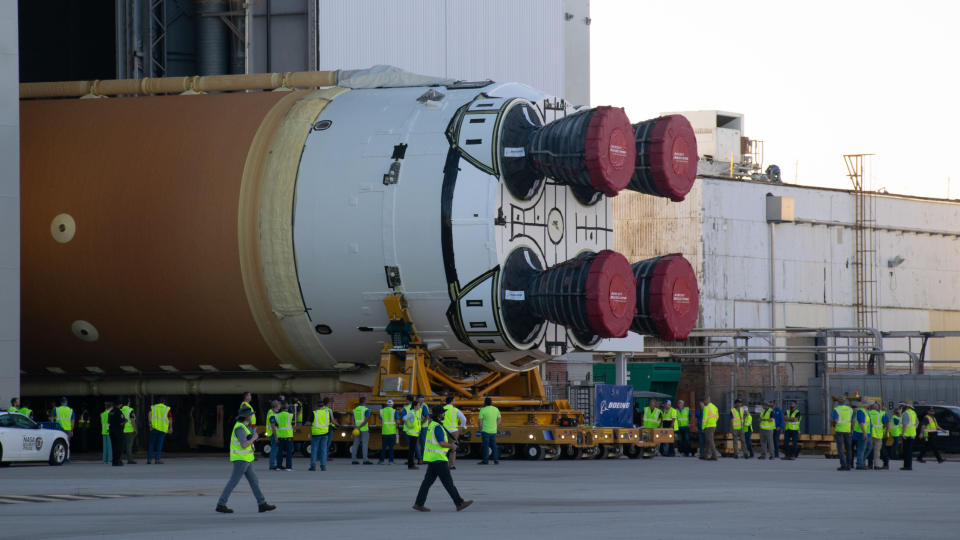
NEW ORLEANS — The core stage of the first rocket to carry astronauts to the moon in more than 50 years has left the production facility and will be integrated into the vehicle and assembled ahead of its launch next year.
NASA’s Space Launch System (SLS) Artemis 2 booster rolled out of the space agency’s Michoud Assembly Facility in New Orleans today (July 16), 55 years after NASA’s Apollo 11 rocket launched to the moon. The 212-foot-long (65-meter) booster, with its four RS-25 engines, was escorted a mile down the road to be loaded onto NASA’s Pegasus barge for shipment to the Kennedy Space Center (KSC) in Florida ahead of the second mission of the Artemis program.
The Artemis 2 mission will launch four astronauts around the moon in 2025, the first humans to make such a lunar journey since the 1970s. The SLS booster began that epic journey by rolling out of the tall hangar doors of Michoud’s Vertical Assembly Center around 7:30 a.m. CDT (12:30 GMT) on Tuesday. A few hundred spectators, mostly Michoud employees and their guests, gathered in the early humid New Orleans morning to watch their historic rocket stage be ferried to the next stop on the way to a lunar mission launch.
The ceremonial event began with “Oh When the Saints” by the Roots of Music Marching Crusaders, a local school marching band, kicking off the morning panel of speakers as the booster rolled past a large gate into the main parking lot. Almost out of sight, the booster turned onto the main road and rolled on toward Pegasus.
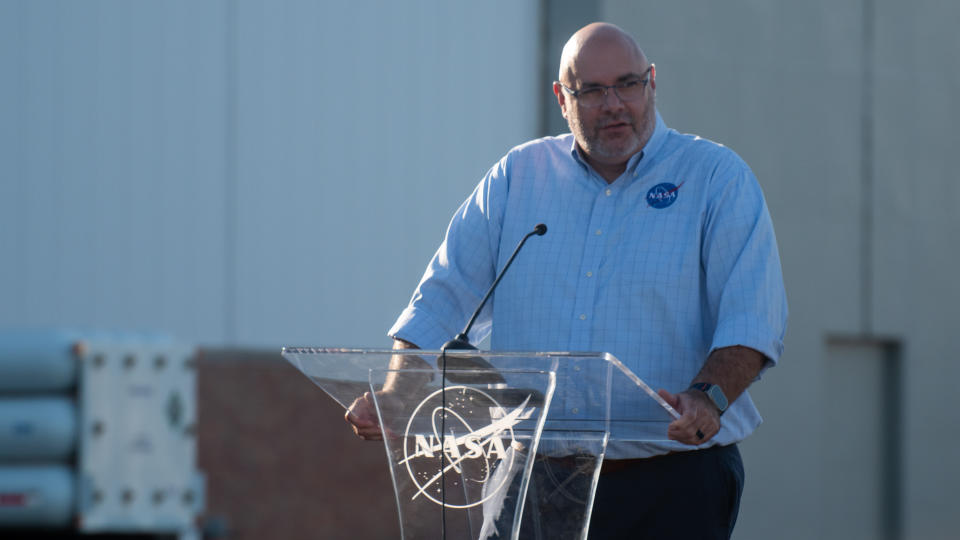

“For more than six decades, Marshall and Michoud have been responsible for some of this country’s greatest achievements in space exploration, from the astonishing feats of the Apollo missions, to 135 shuttle missions, to the milestone we celebrate here today,” said Joseph Pelfrey, director of NASA’s Marshall Space Flight Center, in his opening remarks to the crowd.
In his address to the crowd, which consisted largely of employees who had worked on this SLS booster over the past few years, he emphasized: “We are here today to celebrate the hardware, but it is the people who got us here and who achieved the milestones that help us achieve our mission goals.”
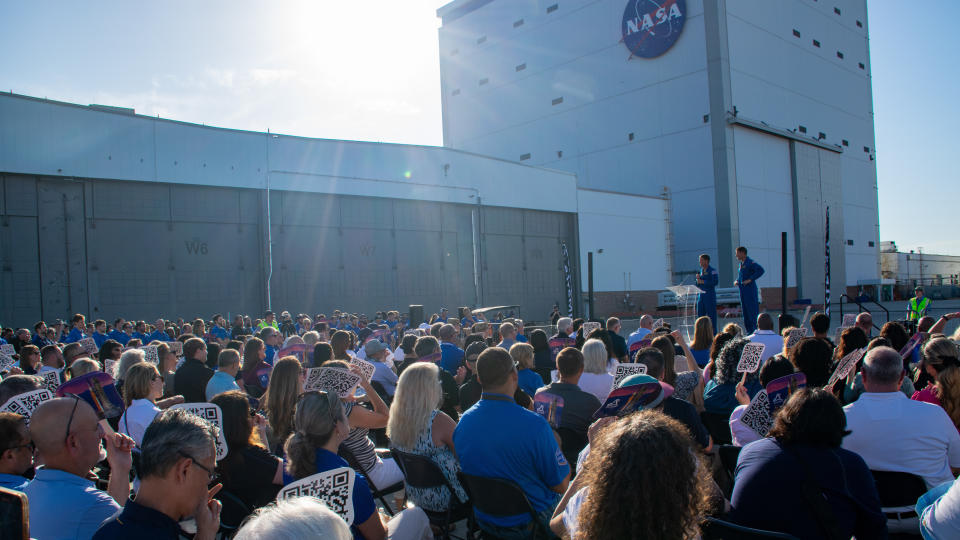

As small milestones are reached in the preparation for each Artemis mission, the Artemis program as a whole is coming into focus. NASA’s goal with Artemis is to establish a permanent presence on the moon near the lunar south pole, which contains high concentrations of water ice — an incredibly useful resource in space that can be used to create everything from drinking water to rocket fuel. The idea is that such an outpost could serve as a springboard to refine technologies and requirements to one day replicate something similar on Mars, but that’s still a ways off.
Related: ‘That’s Part of Space Exploration’: Artemis 2 Astronauts Unimpressed by Moon Mission Delays (Exclusive)
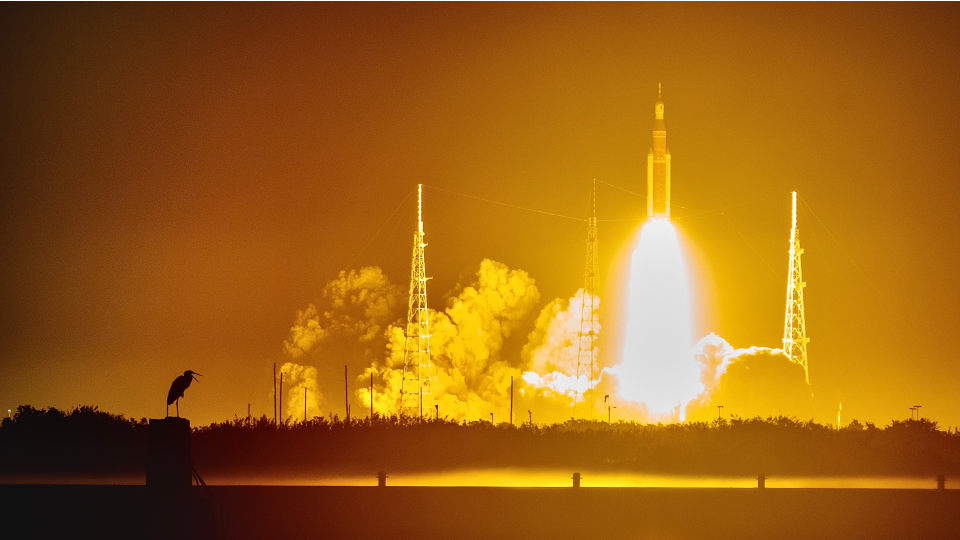

The first Artemis mission launched on November 16, 2022, and put an unmanned Orion spacecraft into lunar orbit. It returned to Earth a few weeks later, on December 11, for an ocean splashdown. Artemis 2 won’t last as long (about 11 days) and technically won’t go into lunar orbit either.
Instead, NASA astronauts Reid Wiseman, Victor Glover, Christina Koch and Jeremy Hansen of the Canadian Space Agency (CSA) will launch a lunar free-return orbiter around the moon, circling it once before being gravitationally flung back to our blue planet. Such an orbit will return Orion to Earth, while the crew of Artemis 2 will perform the spacecraft’s first manned flight.
At launch, Artemis 2 will be the first excursion to bring astronauts within orbital proximity of the moon since the last Apollo mission in 1972, far from the only “first” checked off by the upcoming flight. Three of Artemis 2’s four crew members represent demographic groups that will fly to the moon for the first time in history. Glover, who will serve as the mission’s pilot, will be the first person of color to fly around the moon, Koch the first woman, and Hansen the first non-American.
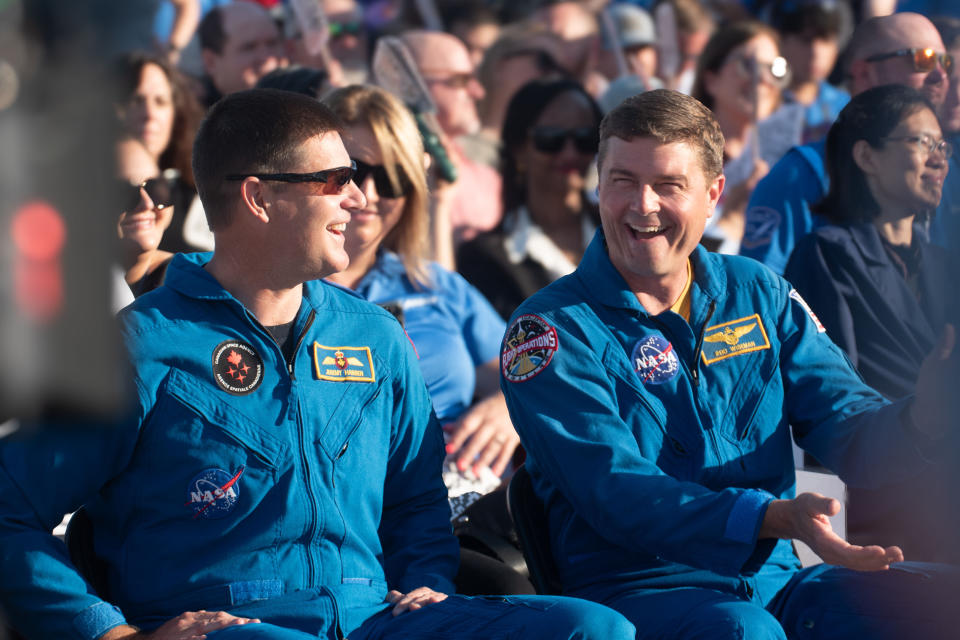

Wiseman and Hansen were also there, watching in amazement as they looked at the rocket that would take them into space.
“I mean, it’s an awesome sight,” Wiseman told Space.com. “We talk a lot about Artemis, about flying to the moon, and I think sometimes it’s forgotten that the hardware is here,” he said, continuing: “The Orion spacecraft is at Kennedy Space Center. Our boosters are at Kennedy Space Center, we just watched the core stage roll by. The next stop is Kennedy Space Center, all the pieces are coming together. And when you actually look at the rocket, and you think about all the people here in Mississippi, in Louisiana, in Alabama and then all across the United States who put this thing together, from conceiving it to actually building it; that’s what America is all about. I think it’s awesome. It’s awesome,” Wiseman said.
Following the success of Artemis 1 in 2022, Artemis 2 was scheduled for November 2024. However, NASA decided to postpone the mission due to suboptimal performance of several systems on the Orion spacecraft, including problems with the heat shield during re-entry, and problems with some of the life support hardware built into Orion for Artemis 2.
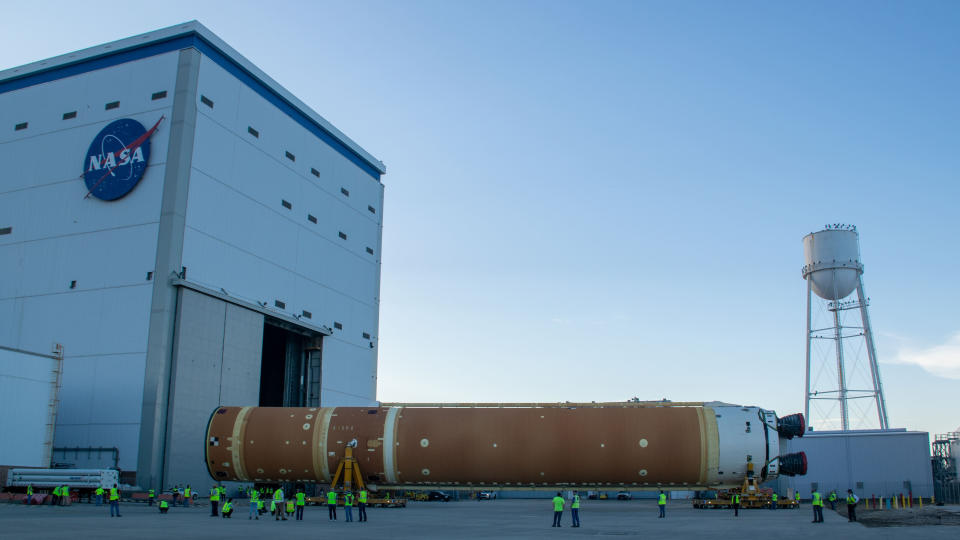

“If we want to achieve great things, we must all work together, all contributions must be put into the effort. And this [booster] is just a small example of this. And it’s a very visual example, when we throw four people around the moon on Artemis 2,” Hansen told Space.com after the booster rolled out of sight.
Because Artemis 2 was not scheduled to launch until September 2025, NASA also delayed the next mission by a year. The goal is to launch Artemis 3 no earlier than September 2026. However, that mission has its own hardware dependencies that could delay the launch even further.
Artemis 3 is the first project in the program designed to land astronauts on the lunar surface. But to do so, key pieces of mission hardware must also be completed, including SpaceX’s Starship, which NASA has contracted to use as the lunar lander for the mission.
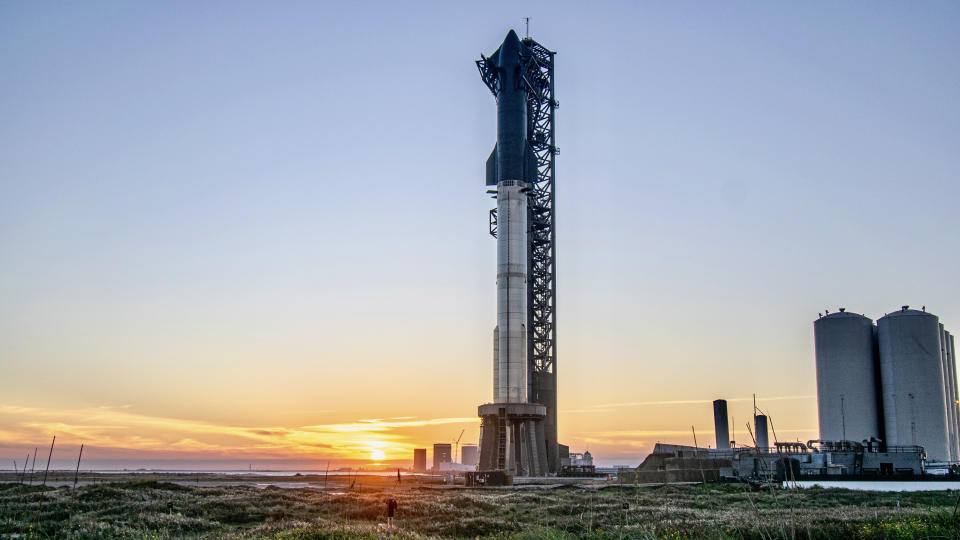

Test flights on Starship have already begun, with a fifth expected before the end of the summer, but for a spacecraft that hasn’t even been to orbit yet, 2026 is an aggressive timeline. Newly designed extraterrestrial-use spacesuits that Artemis 3 astronauts can don as they traverse the lunar surface are being built by Houston-based company Axiom Space and also await completion.
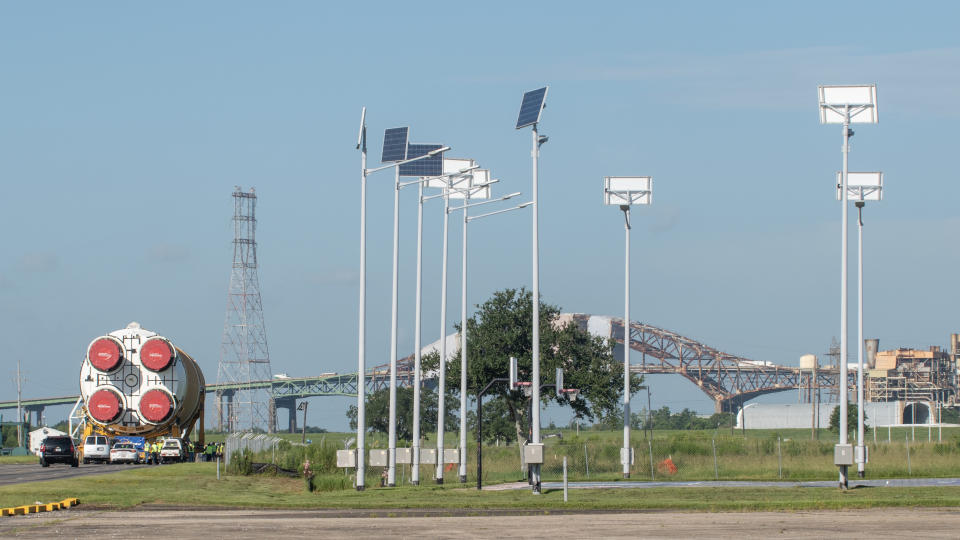

As for the Artemis 2 booster, after its one-mile journey Tuesday morning, the rocket will rest aboard NASA’s Pegasus barge as it leaves the swampy waters off New Orleans for a 900-mile journey across the Gulf of Mexico to the Kennedy Space Center in Cape Canaveral, Florida. Pegasus is expected to arrive at that spaceport on July 23, where its stage will then be transferred from the barge to the Vehicle Assembly Building, across the street.
Related Stories:
— NASA inspector general finds problems with Orion’s heat shield pose ‘significant risks’ to Artemis 2 crew safety
— ‘We’re Ready:’ New NASA Documentary Previews Artemis 2 Moon Mission (Video)
— NASA’s Artemis 2 moon mission: Live updates
Once inside, the booster will undergo a series of systems and hardware checks before being outfitted with the remaining rocket components and stages, including the two solid rocket boosters, the Interim Cryogenic Propulsion Stage used to launch Orion into orbit and demonstrate Orion’s close-range operations, the Orion spacecraft itself and its associated service module.